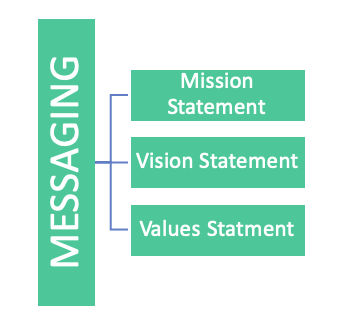The strategic planning process provides opportunities to examine specific problems, generate a renewed commitment to marketing and communication, and to present the ideal opportunity to promote teamwork amongst members of the entire group. Strategic planning, whether it is short, mid or long-term, assists organization for the long run, as they monitor progress and measurement to achieve goals. This process provides the ability to remain flexible, and to change course, if necessary (Barry, 2012).
These components all help to establish positioning, an essential piece to understand internal and external context. That is to say, where the organization stands in the market place, and to clarify any future marketing messages for any organization.
Cohesive messaging will help communicate this kind of differentiation. An excellent place to start this kind of broad message for an organization is with solid values, vision and mission statements. (Keffer, 2014)

Values Statement: Any Mission and Vision Statements must be supported first by a Values Statement. Values are the foundation of any organization. This statement represents an organization’s core beliefs, which ultimately guide behavior (Joyaux, 2015).
- What does your organization stand for?
Vision Statement: The Vision Statement states the long-term goal of an organization. This statement will help any organization as they develop their Mission Statement (Keffer, 2014).
- Where will your organization be in five to ten years?
Mission Statement: This Mission Statement is ideally made up of 25 words or less, and answers three questions;
- What would your organization like to do?
- Who does your organization serve?
- How will your organization impact the community?
An organizational Mission serves to guide the day-to-day activities of an organization. The mission statement is not a tagline, and should ultimately describe the strategy (Pandolfi, 2011). This will facilitate evaluation, an essential activity.
All three of these components make up and communicate the overarching organizational impression or concept that is shared both internally and externally. These statements should be easy to understand and easy to remember for a variety of stakeholders for optimal communication. This is best achieved in a multi-step process and should occur over a time frame of several weeks, and even months through a diverse Development Team representing different backgrounds, tenure and expertise (Keffer, 2014).
